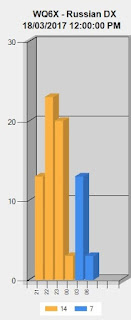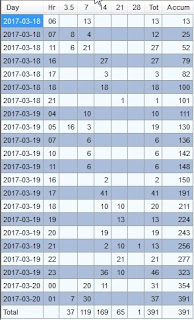 |
| NX6T - STATION #1 |
To read my write up on last year's event [CLICK HERE].
[CLICK HERE] to read the 2017 BARTG contest rules.
Similar to 2016, an attempt was made to work the LAQP and VAQP QSO parties.
Unlike last year, in 2017 I actually made QSOs in those parties (2 Q's with Virginia
and 3 Q's with Louisiana). Ironically, the two VA QSOs should technically win a 1st place,
being that I submitted the log as a single-band 20-meter CW entry.
Because many state QSO parties are only 12 hour GiGs, by the time 40 meters opens to
the right-coast (for us on the left-coast), unfortunately, the QSO party is usually over.
 |
| Tower-1 (below) Tower-2 (above) |
as well as the state QSO parties.
To make things easier, I used the Elecraft K3 to drive the ACOM 2000-a amplifier to a comfortable 550 watts; on both CW and RTTY. While the amp warmed the room considerably, it ran cool - as amplifiers go.
In order to be effective in 4 contests, somehow, SLEEP needs to occur in sufficient quantity; whether in large blocks, or hour-long swatches, when the eyes can no longer remain open.
Compared to the 2016 setup, the quality of remote operating @ NX6T has improved considerably.
This last weekend, when the internet was happening
in Fallbrook, it was like a super highway.
Unfortunately, there were unexpected and unexplained connection failures which would
end up costing upwards of 30 minutes in lost OP time. I missed a number of brief band
openings because of that.
Typical of most contests I participate in, I made a late start - 06:17z being the 1st log entry as it took several hours to resolve some internet and then audio conflicts. However once things got started what was left of friday evening became immediately productive.
One of my goals for the BARTG RTTY contest was to utilize it as a "training ground" for improving my RTTY operating style.
When I have a radio in front of me, tuning RTTY signals "by hand" is relatively EASY; that same action
when made by way of the internet
can be tricky at best.
Something new for this contest was the inclusion of the F-10 key as a "NOW" key. Properly designed, the NOW key allows you to invoke F3 ("TU QRZ?"), log the QSO, pop the next call
off the stack into the callsign window and invoke F2; all from one key press.
While I ran frequencies most of the time, circumstances were such that I only got to use the NOW feature twice. What makes the NOW key tricky is when the decoder deciphers what it thinks is a callsign while I am copying the exchange from the current station. Now that GARBAGE is on
the call stack and needs to be deleted before the NOW key will work properly.
Unless I just "happen" onto a properly tuned RTTY signal (as happened for 2% of contacts made),
or bandmap-click a perfectly spotted spot, I simply look for a "clear" frequency from which to
send: "CQ BARTG Test de WQ6X WQ6X Test".
In RTTY contests, it is expected that stations will be operating above the .100 boundary in each amateur band. The WQ6X run frequencies fit in with this:
14114.14, 21104.04, 14109.09, 14110.10, and even 21099.99.
One of my RTTY contest BEEFs is that the 14.100 beacon frequency is ALWAYS FLOODed
with RTTY stations because operators are either ignorant of the fact, or do not care, that non-RTTY amateurs rely on that NCDXF beacon. Having a beacon does us NO good if no one can hear it due to RTTY QRM. What? You didn't KNOW 14.100 was a beacon frequency? Well, NOW you Do!
Do the right thing; offer +/- 3 or more Kc to beacons and make EVERYONE happy.
In virtually EVERY contest I operate, once my callsign is heard calling [effectively] "CQ Contest", my run frequencies become fair game for intentional QRM.
Running RTTY hardly shields me from intentional QRM. Sometimes it is REAL OBVIOUS.
I PURPOSELY choose weird (i.e. unique) run frequencies. Therefore when I see a PERFECT COPY "CQ Test..." message decode before me,
I KNOW that station's choice of frequency is no accident;
especially if I have been on that frequency for nearly an hour.
To resolve this, whether the mode is CW or RTTY, I always have a specific N1MM+ function key defined that allows me to essentially send "QRL / QSY" each time the key is pressed. If that does not work, I type QSYLID into the callsign field and press F5 as needed until the IDIOT finally vacates.
During the Russian DX contest, at one point while calling CQ, at 22:30z a station came on frequency just below my run frequency (14025.75), first tuning up and then sending a series of continuous dits, for what turned out to be over an hour. After 30 minutes I vacated the frequency for other pursuits, finding the dits singing away over 1/2 hour later when I checked back. Amazing. While CQ'ing on 7018.18 I was greeted with what sounded like a "data cranker" machine.
The polar flutter made it sound like a toilet flushing.
Auroral influenced signal flutter was all over 20 meters. At 17:00z the flutter was so pronounced it put a weird flutter on "G" stations (England) and made a W5 station sound like it was coming from EU. This is good reason for sending your callsign THREE TIMES. The demodulator may garble
one of them, but the other two will confirm each other.
One of the things I like about the BARTG contest is its adherence to what I call the
multiplier/call-area rule. Taken from the BARTG rules web page, it reads:
"Stations in areas that count as multipliers whose callsign does not reflects the correct area must append the area after their call. E.G. W1XXX/4. Penalty will be the log becomes CHECKLOG"
Amidst the BARTG RTTY pandemonium I found time to play in the Russian DX contest.
While it is a multi-mode contest, when I am running remotely, I prefer sending serial numbers by way of CW; pressing a key is easier than configuring transmit audio signals over the internet and using my
own voice (voice keyers are no good
for Serial #'s).
Propagation-wise, 10 & 15 meters were virtually a no-show on Saturday, even though I put out numerous "CQ Test"
calls throughout the day.
On Sunday, pointing the C-31 yagi to 240-degrees yielded KH6CJJ on 28084.84; what turned out to be the ONLY 10 meter contact.
At least I can now say that I played 10 meters.
Did YOU play 10 meters?
When 10 meters could deliver no more, the switch was made to 15 meters just in time for an extensive JA opening, while also working persistent U.S. stations off the end of the C-31 yagi.
As usual, because my preoccupation was with the BARTG RTTY contest, I did not make my way down into the CW band for the Russian DX contest until 21:30z (2:30 PDT). I had JUST run out of EU
stations to work on RTTY; knowing the band was wide-open
dropping down to CW to pick them up made sense to me.
Eventually I settled in on several run frequencies including 14007.07, 14026.26 & 14036.36, before transitioning down to 40-meters at 03:00z Unlike RTTY, on 40-meter CW I spent most of the time S&P'ing, instead of frequency running. The worth in EU multipliers is inestimable.

While I didn't spend nearly enough time on CW, the Russian DX contest helped reinforce my recognition of the fact that we are at the bottom of sunspot cycle 24. That means considerably earlier 40-meter openings to EU; even from the San Diego area.
In looking at the log, I am confused by the fact that there are no 80 meter QSOs made in the Russian DX contest. While not a GREAT antenna, the 80-m inverted vee @ NX6T has been known to work EU, and in particular, those countries bordering the Atlantic like EA, CR, CT, DR, and all their variants.
I guess I can't think of EVERYTHING.
In the midst off BARTG and the Russian DX GiGs, I put in several
CW listens for and VA or LA stations calling for their QSO party.
In the midst off BARTG and the Russian DX GiGs, I put in several
CW listens for and VA or LA stations calling for their QSO party.
The LAQP ended at 02:00z (Saturday evening for me). Unfortunately, by the time I made it to 40-meters the QSO party had JUST ended. This is yet ANOTHER reason QSO parties should have extended ending times.
At least the VAQP had another 12 hour slot on Sunday allowing me to take the number of log entries from ONE to TWO. Ironically, according to 3830Scores.com, that may be enough to qualify for a 1st place in the 20-meter CW category.
At least the VAQP had another 12 hour slot on Sunday allowing me to take the number of log entries from ONE to TWO. Ironically, according to 3830Scores.com, that may be enough to qualify for a 1st place in the 20-meter CW category.

This is once again proof of why you should ALWAYS submit your log
after dabbling in a radio contest.
after dabbling in a radio contest.
If I am capable of setting up that contest in N1MM+, then the LEAST I can do is submit the resultant log when it is all over. Time-wise, less than 10 minutes
is needed to make it all happen.
is needed to make it all happen.
To sum it all up, this was a typical last minute radiosport contest operation. While the radio equipment performed flawlessly (no amplifier faults), sudden internet "collapses" made this a tricky operation.
If I seemed to "disappear" on you, and then come back suddenly, it was NOT because I was improperly running SO2R, it is because something I could not control (an internet outage) suddenly made the scene .
While I probably won't receive any awards (except the 2-QSO 1st place in the VAQP), this weekend gave my operating skills a REAL workout.
Did YOU operate in the BARTG RTTY or Russian DX contest on CW?
If so, is WQ6X in YOUR Log?
------------------------------------------------------------------------------------------------------------------------------
June 16th Update:
Today I received a 1st place certificate for the VAQP.
This is again the reason to ALWAYS submit a log - no matter how small the score.





No comments:
Post a Comment